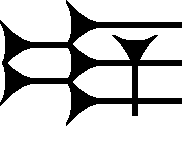Tur (cuneiform) on:
[Wikipedia]
[Google]
[Amazon]
 The
The
.....
.....
It is found in various Amarna letters as part of ''"Messenger-Xxxxx"'', for example " LÚ. PA.TUR-Uv-wx-yz"
File:B252ellst.png, Alphabetic cuneiform i,
Cuneiform signs
{{Semitic-lang-stub
 The
The cuneiform
Cuneiform is a Logogram, logo-Syllabary, syllabic writing system that was used to write several languages of the Ancient Near East. The script was in active use from the early Bronze Age until the beginning of the Common Era. Cuneiform script ...
sign for tur is used to denote one syllabic usage, ''tur'', or the sign's Sumerogram
A Sumerogram is the use of a Sumerian cuneiform character or group of characters as an ideogram or logogram rather than a syllabogram in the graphic representation of a language other than Sumerian, such as Akkadian, Eblaite, or Hittite. Th ...
s; it is used in the Epic of Gilgamesh
The ''Epic of Gilgamesh'' () is an epic poetry, epic from ancient Mesopotamia. The literary history of Gilgamesh begins with five Sumerian language, Sumerian poems about Gilgamesh (formerly read as Sumerian "Bilgames"), king of Uruk, some of ...
and the 14th century BC Amarna letters. The sign is based on the i (cuneiform)
The cuneiform i sign is a common use vowel sign. It can be found in many languages, examples being the Akkadian language of the ''Epic of Gilgamesh'' (hundreds of years, parts of millenniums) and the mid 14th-century BC Amarna letters; al ...
sign, with the one small added vertical stroke.
Besides ''tur'', it is for Sumerograms (logogram
In a written language, a logogram (from Ancient Greek 'word', and 'that which is drawn or written'), also logograph or lexigraph, is a written character that represents a semantic component of a language, such as a word or morpheme. Chine ...
s) B├ĆN, DUMU, and TUR. In the Epic of Gilgamesh, it is used in the following numbers: ''tur''-(11 times), ''B├ĆN''-(3), ''DUMU''-(25), ''TUR''-(2). The large usage of ''DUMU'' in the Epic is for the Sumerogram being the equivalent of "son", Akkadian language
Akkadian ( ; )John Huehnergard & Christopher Woods, "Akkadian and Eblaite", ''The Cambridge Encyclopedia of the World's Ancient Languages''. Ed. Roger D. Woodard (2004, Cambridge) Pages 218ŌĆō280 was an East Semitic language that is attested ...
"m─üru".
Amarna letter usage
In the Amarna letters, the topic ofAmarna letter EA 296
Amarna (; ) is an extensive ancient Egyptian archaeological site containing the ruins of Akhetaten, the capital city during the late Eighteenth Dynasty. The city was established in 1346 BC, built at the direction of the Pharaoh Akhenaten, and a ...
, ''Under the Yoke,'' is the guarding of two cities, at the city gate; also the man authoring the letter, Yabitiri-(Yahtiru)-(governor?) of City? gives his history of going to Egypt to be trained with the Pharaoh, EA 296, line 25 ( tablet reverse): ''"... (25) "i-nu- ma TUR a-na-ku", (26) he (Yanhamu) took me to (Egypt) Misri (27)...'', ''(25) "Now when "YOUNG"-(I, myself), (26) he (i.e. Yanhamu) took me to Egypt, (27) ..."''
Common text usage
The most common text usage is unlike the digital version. It is composed of 5-horizontals: one (single) above two pairs of two, and all sitting on a large single horizontal stroke, approximated as follows: .........
.....
It is found in various Amarna letters as part of ''"Messenger-Xxxxx"'', for example " LÚ. PA.TUR-Uv-wx-yz"
References
* Moran, William L. 1987, 1992. ''The Amarna Letters.'' Johns Hopkins University Press, 1987, 1992. 393 pages.(softcover, ) * Parpola, 1971. ''The Standard BabylonianEpic of Gilgamesh
The ''Epic of Gilgamesh'' () is an epic poetry, epic from ancient Mesopotamia. The literary history of Gilgamesh begins with five Sumerian language, Sumerian poems about Gilgamesh (formerly read as Sumerian "Bilgames"), king of Uruk, some of ...
'', Parpola, Simo, Neo-Assyrian Text Corpus Project
The Neo-Assyrian Text Corpus Project is an international scholarly project aimed at collecting and publishing ancient Assyrian texts of the Neo-Assyrian Empire and studies based on them. Its headquarters are in Helsinki in Finland.
State Archives ...
, c 1997, Tablet I thru Tablet XII, Index of Names, Sign List, and Glossary-(pp. 119ŌĆō145), 165 pages.
----
I (cuneiform)
The cuneiform i sign is a common use vowel sign. It can be found in many languages, examples being the Akkadian language of the ''Epic of Gilgamesh'' (hundreds of years, parts of millenniums) and the mid 14th-century BC Amarna letters; al ...
; (there is only a, e, i, u (four vowels); also ( ├║, commonly ( u, 1st prime)), or ├╣-(for "and")).